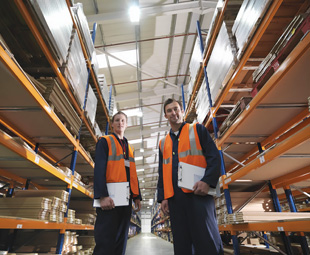The ‘apply’ chain

People would be miserable and economies would suffer if it were not for the modern-day supply chain. DANIELLE DU TOIT looks at international trends affecting this sector.
From milk in the morning to life-saving medicine, the world depends on reliable warehousing, logistics and distribution. To manage these disciplines while turning a profit calls for ever-greater efficiencies.
With the global need to trim costs and respond to the think-green mindset, trend forecasts suggest that 2012 will lead to bigger warehouses and regional warehousing, with warehouses no longer just storage sites.
“South Africa is about 25 years behind Europe and 15 years behind America when it comes to warehousing,” says Fred Albrecht, managing director of APC Storage Solutions. “The East is investing heavily in automation, which counters the belief that only small developed countries can afford it. A complete mind shift needs to take place. As soon as local supply chains see the effects on the bottom line, South Africa will follow.”
Warehouse management systems (WMS) and warehouse control systems (WCS) are becoming standard. A WMS will plan an activity forecast based on statistics, trends and so on, while a WCS acts like a floor supervisor, working in real time to get the job done. These automated systems manage stock, keep inventory, place orders, make warehouse space available, capture the receipt and dispatch of items, and are closely linked with the logistics arm in determining what needs to go where. With the implementation of this technology, together with regional warehousing, tailoring can be done to suit specific customer needs, and will lead to lower fuel usage.
But automation doesn’t come without risk, says Albrecht – as Sasol Polymers learnt with its fully automated plant. “It was a total failure due to the integration consultants. Everything, from sheeting to WMS/WCS integration, failed.”
Logistics management, the control of the flow of goods from source to end point, involves all actions in the supply chain – from transportation and inventory to warehousing and materials handling – and extends beyond the handling of physical goods to include information management.
Globalisation calls for goods to able to reach anywhere in the world and has led to an increase in third party logistics (3PL) integration and business to business (b2b) partnerships. Customisation is a key requirement. Customers want solutions that meet their needs. Winning logistics providers are those who can balance the need for excellence in execution with the ability to save the customer money.
Internationally, we are seeing a move toward rail. Increasing fuel prices and driver shortages leave logistics operators few options. Software systems have allowed total landed costs (TLC) to be scrutinised in detail, and have revealed that labour in China and India is costing more. A move toward employing locally is being felt. With South Africa’s unemployment rate at 25,5 percent at year-end 2011, these local-employment trends will not only benefit the logistics market but the economy too.
Climate change was a big talking point in the 2011 edition DHL Delphi Magazine – the annual magazine that predicts futures trends in logistics. We are already seeing longer European winters, droughts in the US, volcanic eruptions and earthquakes. Smart operators will try to prepare for such events, and increasing focus will be placed on issues such as terrorism, crime, war and piracy. Since 2010, more than 50 cargo vessels and super tankers have been captured or hijacked by Somali pirates, each vessel worth millions. These are threats that logistics providers have to examine more closely.
Fuel and manufacturing costs have put pressure on the cost of consumer products – and strategic ways to drive down costs will target the distribution process, from storage and refrigeration to warehousing and delivery.
Methods include cross-docking, where products don’t touch the ground from initial transportation to point of sale. Inbound suppliers hand goods over to outbound vehicles with very little, if any, storage time in between. Simple solutions such as smart packing methods designed to save space are also applied. A key performance indicator (KPI) measures the percentages of on-time deliveries and pick-ups, and together with the cost per square metre, establishes the productivity-versus-costs factor in the operation.
With employee costs representing up to 70 percent of total operating costs, technology to reduce labour costs is another area of focus. Automated ways to handle order processing, billing, inventory control, scheduling and warehouse management are brought in to minimise costs and errors. Order processing software can be used to make executive decisions based on the nature of the product, the nature of the order, packaging specifics, logistical costs, availability of products and workforce. It can also quantify the predictability of future volumes and distribution networks.
Collectively, the trend is a move towards achieving maximum efficiency in all areas – efficient warehousing, efficient staff, efficient vehicles and efficient software.
The ultimate aim is a seamless supply chain that operates so well that it delivers even when it doesn’t. If that sounds like an oxymoron, consider this: when you run into the local supermarket to purchase that jam that you like, if it’s not on the shelf, it will be ordered, sourced and perhaps even delivered to your house that very same day. This is the future of warehousing, logistics and development.
Published by
Focus on Transport
focusmagsa



